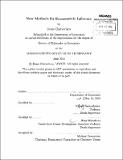| dc.contributor.advisor | Victor Chernozhukov and Anna Mikusheva. | en_US |
| dc.contributor.author | Chetverikov, D. N. (Denis Nikolaevich) | en_US |
| dc.contributor.other | Massachusetts Institute of Technology. Department of Economics. | en_US |
| dc.date.accessioned | 2013-09-24T19:38:45Z | |
| dc.date.available | 2013-09-24T19:38:45Z | |
| dc.date.copyright | 2013 | en_US |
| dc.date.issued | 2013 | en_US |
| dc.identifier.uri | http://hdl.handle.net/1721.1/81039 | |
| dc.description | Thesis (Ph. D.)--Massachusetts Institute of Technology, Dept. of Economics, 2013. | en_US |
| dc.description | Cataloged from PDF version of thesis. | en_US |
| dc.description | Includes bibliographical references (p. 201-208). | en_US |
| dc.description.abstract | Monotonicity is a key qualitative prediction of a wide array of economic models derived via robust comparative statics. It is therefore important to design effective and practical econometric methods for testing this prediction in empirical analysis. Chapter 1 develops a general nonparametric framework for testing monotonicity of a regression function. Using this framework, a broad class of new tests is introduced, which gives an empirical researcher a lot of flexibility to incorporate ex ante information she might have. Chapter 1 also develops new methods for simulating critical values, which are based on the combination of a bootstrap procedure and new selection algorithms. These methods yield tests that have correct asymptotic size and are asymptotically nonconservative. It is also shown how to obtain an adaptive rate optimal test that has the best attainable rate of uniform consistency against models whose regression function has Lipschitz-continuous first-order derivatives and that automatically adapts to the unknown smoothness of the regression function. Simulations show that the power of the new tests in many cases significantly exceeds that of some prior tests, e.g. that of Ghosal, Sen, and Van der Vaart (2000). An application of the developed procedures to the dataset of Ellison and Ellison (2011) shows that there is some evidence of strategic entry deterrence in pharmaceutical industry where incumbents may use strategic investment to prevent generic entries when their patents expire. Many economic models yield conditional moment inequalities that can be used for inference on parameters of these models. In chapter 2, I construct a new test of conditional moment inequalities based on studentized kernel estimates of moment functions. The test automatically adapts to the unknown smoothness of the moment functions, has uniformly correct asymptotic size, and is rate optimal against certain classes of alternatives. Some existing tests have nontrivial power against n-1/2 -local alternatives of a certain type whereas my method only allows for nontrivial testing against (n/ log n)-1/2-local alternatives of this type. There exist, however, large classes of sequences of well-behaved alternatives against which the test developed in this paper is consistent and those tests are not. In chapter 3 (coauthored with Victor Chernozhukov and Kengo Kato), we derive a central limit theorem for the maximum of a sum of high dimensional random vectors. Specifically, we establish conditions under which the distribution of the maximum is approximated by that of the maximum of a sum of the Gaussian random vectors with the same covariance matrices as the original vectors. The key innovation of this result is that it applies even when the dimension of random vectors (p) is large compared to the sample size (n); in fact, p can be much larger than n. We also show that the distribution of the maximum of a sum of the random vectors with unknown covariance matrices can be consistently estimated by the distribution of the maximum of a sum of the conditional Gaussian random vectors obtained by multiplying the original vectors with i.i.d. Gaussian multipliers. This is the multiplier bootstrap procedure. Here too, p can be large or even much larger than n. These distributional approximations, either Gaussian or conditional Gaussian, yield a high-quality approximation to the distribution of the original maximum, often with approximation error decreasing polynomially in the sample size, and hence are of interest in many applications. We demonstrate how our central limit theorem and the multiplier bootstrap can be used for high dimensional estimation, multiple hypothesis testing, and adaptive specification testing. All these results contain non-asymptotic bounds on approximation errors. | en_US |
| dc.description.statementofresponsibility | by Denis Chetverikov. | en_US |
| dc.format.extent | 208 p. | en_US |
| dc.language.iso | eng | en_US |
| dc.publisher | Massachusetts Institute of Technology | en_US |
| dc.rights | M.I.T. theses are protected by
copyright. They may be viewed from this source for any purpose, but
reproduction or distribution in any format is prohibited without written
permission. See provided URL for inquiries about permission. | en_US |
| dc.rights.uri | http://dspace.mit.edu/handle/1721.1/7582 | en_US |
| dc.subject | Economics. | en_US |
| dc.title | New methods for econometric inference | en_US |
| dc.type | Thesis | en_US |
| dc.description.degree | Ph.D. | en_US |
| dc.contributor.department | Massachusetts Institute of Technology. Department of Economics | |
| dc.identifier.oclc | 857791328 | en_US |
